Navigation
Assumptions About Fish Populations' Fluctuations Challenged by New NSF Research
According a National Science Foundation (NSF), scientific literature and fisheries management and conservation efforts have for years assumed that the survival of adult fish is relatively constant through time. They further held that most fluctuations in the numbers of adults come from variation in the number of young fish that are produced and survive to maturity. Those assumptions have been challenged by new research by the National Science Foundation's Long-Term Ecological Research (LTER) Network.
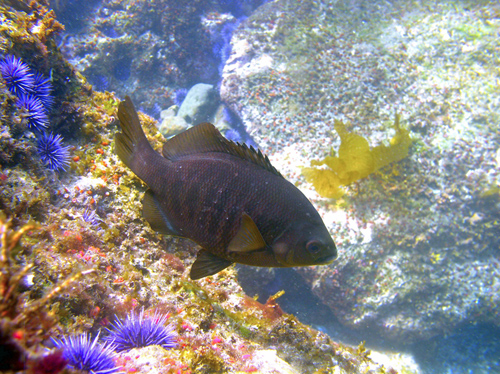 A black surfperch, subject of the study, swimming in the vicinity of Santa Cruz Island.: Photograph by Clint Nelson courtesy of NSF
A black surfperch, subject of the study, swimming in the vicinity of Santa Cruz Island.: Photograph by Clint Nelson courtesy of NSF
According to the National Science Foundation (NSF), scientific literature and fisheries management and conservation efforts have for years assumed that the survival of adult fish is relatively constant through time. They further held that most fluctuations in the numbers of adults come from variation in the number of young fish that are produced and survive to maturity.
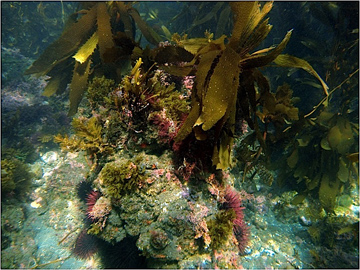 Kelp habitat in which black surfperch hunt for prey at Santa Cruz Island, California.: Photograph by Clint Nelson courtesy of NSF
Kelp habitat in which black surfperch hunt for prey at Santa Cruz Island, California.: Photograph by Clint Nelson courtesy of NSF
Those assumptions have been challenged by new research by the National Science Foundation's Long-Term Ecological Research (LTER) Network. One of the National Science Foundation’s 20 part series on the LTER findings released on 30 November 2015 reveals that fluctuating food supplies and competition can alter the survival of adult fish -- at least for a Pacific marine reef species -- and can be a major cause of changes in their populations.
In the study, biologists Daniel Okamoto, Russell Schmitt and Sally Holbrook of the University of California, Santa Barbara, analyzed fish records collected over more than a quarter of a century.
Black surfperch survival
The analyses showed that for black surfperch (Embiotoca jacksoni), survival of adults from year to year was strongly linked with both the amount of prey available and the number of fish sharing that food source. The findings appear a letter entitled, “Stochastic density effects on adult fish survival and implications for population fluctuations,” in the journal Ecology Letters available at http://onlinelibrary.wiley.com/doi/10.1111/ele.12547/full.
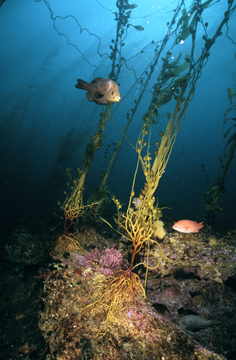 Denizen of a giant kelp forest: the black surfperch.: Photograph by Ron McPeak courtesy of NSF"We found that the survival rate varies through time, and is driven by local-scale processes of food variability and competition for that food supply," said lead paper author Okamoto, now at Simon Fraser University in British Columbia. "That can have major implications for how we think about the effect of fishing on fish populations.
Denizen of a giant kelp forest: the black surfperch.: Photograph by Ron McPeak courtesy of NSF"We found that the survival rate varies through time, and is driven by local-scale processes of food variability and competition for that food supply," said lead paper author Okamoto, now at Simon Fraser University in British Columbia. "That can have major implications for how we think about the effect of fishing on fish populations.
"Mortality from fishing and other human activities can greatly increase fluctuations in the number of fish in a population over time. That runs counter to management and conservation goals for harvested species."
The time series used in the synthesis came from the National Science Foundation Santa Barbara Coastal LTER site. The facility, part of NSF's LTER Network, is funded by its Divisions of Environmental Biology, Ocean Sciences, and Polar Programs.
Schmitt and Holbrook began surveying the food supply of surfperch on Santa Cruz Island in the early 1980s. Year after year, they returned to the same locations and surveyed the surfperch and their prey, their habitat and different age classes of the fish.
Time series data
"We wanted to know how much the food supply influenced the population dynamics of fish," Schmitt said. "While everyone knows that food matters, we were surprised at how important it was compared with other causes of variation in the number of adult fish on a reef."
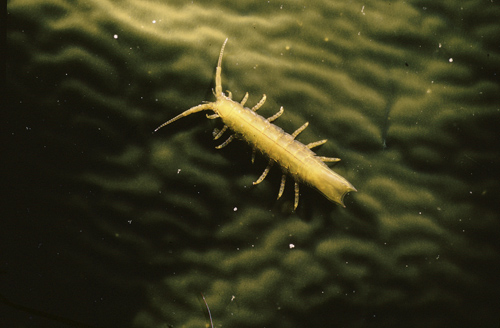 Black surfperch feast on isopods, like this one on a blade of kelp, and other small crustaceans.: Photograph by Dan Okamoto courtesy of NSF
Black surfperch feast on isopods, like this one on a blade of kelp, and other small crustaceans.: Photograph by Dan Okamoto courtesy of NSF
LTER data help scientists understand interactions among species. Okamoto used the data to perform sophisticated statistical modeling of fish populations, and examined interactions among the survival rate, the number of fish present, and abundance of their food.
"There were strong interactions among the amount of food and the fishes' survival rate as well as the number of fish," Okamoto said. "More fish lead to less survival because they're competing for limited prey resources."
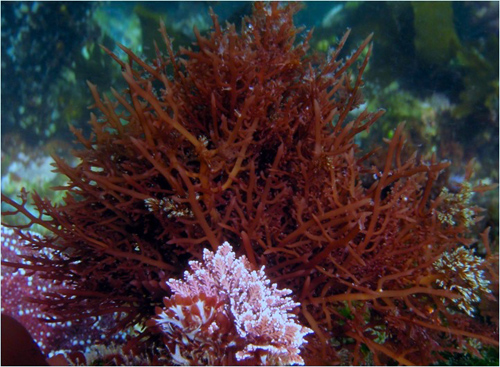 The macroalgae Gelidium robustum is a key habitat in which black surfperch live.: Photograph by Clint Nelson courtesy of NSF
The macroalgae Gelidium robustum is a key habitat in which black surfperch live.: Photograph by Clint Nelson courtesy of NSF
Applicable results
Although the study targeted a single species, the research generalized the results for other fish populations.
"The degree to which survival rates vary through time is huge compared to what people expect in fish populations in the ocean," Okamoto said.
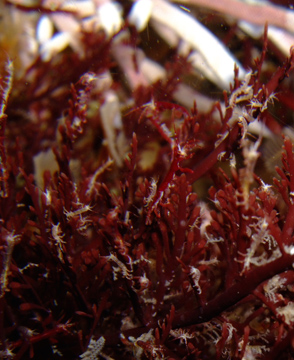 Black surfperch eat the small organisms living on macroalgae, such as these skeleton shrimp.: Photograph by Dan Okamoto courtesy of NSF
Black surfperch eat the small organisms living on macroalgae, such as these skeleton shrimp.: Photograph by Dan Okamoto courtesy of NSF
"It's known that fish species that are harvested tend to fluctuate much more through time compared with species that are not fished,” Holbrook added. “…scientists have speculated about what could cause fishing to increase population fluctuations. Our analyses provide a mechanism by which mortality from fishing and other sources can destabilize a fish population."
Long-term studies, Okamoto said, which look at the processes that give rise to variability, affect how we think about sustainable fisheries and conservation measures.
"We suggest adopting precautionary approaches in fisheries until more is known about the complex relationships that shape fish population dynamics," Schmitt said.
The information in this article is from Part 20 of the National Science Foundation's Long-Term Ecological Research (LTER) Network’s findings published on November 30, 2015. Earlier Parts are available: one, two, three, four, five, six, seven, eight, nine, 10, 11, 12, 13, 14, 15, 16, 17, 18 and 19.
This article was published on the Horizon International Solutions Site on 12 December 2015.
Search
Latest articles
Agriculture
- World Water Week: Healthy ecosystems essential to human health: from coronavirus to malnutrition Online session Wednesday 24 August 17:00-18:20
- World Water Week: Healthy ecosystems essential to human health: from coronavirus to malnutrition Online session Wednesday 24 August 17:00-18:20
Air Pollution
- "Water and Sanitation-Related Diseases and the Changing Environment: Challenges, Interventions, and Preventive Measures" Volume 2 Is Now Available
- Global Innovation Exchange Co-Created by Horizon International, USAID, Bill and Melinda Gates Foundation and Others
Biodiversity
- It is time for international mobilization against climate change
- World Water Week: Healthy ecosystems essential to human health: from coronavirus to malnutrition Online session Wednesday 24 August 17:00-18:20
Desertification
- World Water Week: Healthy ecosystems essential to human health: from coronavirus to malnutrition Online session Wednesday 24 August 17:00-18:20
- UN Food Systems Summit Receives Over 1,200 Ideas to Help Meet Sustainable Development Goals
Endangered Species
- Mangrove Action Project Collaborates to Restore and Preserve Mangrove Ecosystems
- Coral Research in Palau offers a “Glimmer of Hope”
Energy
- Global Innovation Exchange Co-Created by Horizon International, USAID, Bill and Melinda Gates Foundation and Others
- Wildlife Preservation in Southeast Nova Scotia
Exhibits
- Global Innovation Exchange Co-Created by Horizon International, USAID, Bill and Melinda Gates Foundation and Others
- Coral Reefs
Forests
- NASA Satellites Reveal Major Shifts in Global Freshwater Updated June 2020
- Global Innovation Exchange Co-Created by Horizon International, USAID, Bill and Melinda Gates Foundation and Others
Global Climate Change
- It is time for international mobilization against climate change
- It is time for international mobilization against climate change
Global Health
- World Water Week: Healthy ecosystems essential to human health: from coronavirus to malnutrition Online session Wednesday 24 August 17:00-18:20
- More than 400 schoolgirls, family and teachers rescued from Afghanistan by small coalition
Industry
- "Water and Sanitation-Related Diseases and the Changing Environment: Challenges, Interventions, and Preventive Measures" Volume 2 Is Now Available
- Global Innovation Exchange Co-Created by Horizon International, USAID, Bill and Melinda Gates Foundation and Others
Natural Disaster Relief
- STOP ATTACKS ON HEALTH CARE IN UKRAINE
- Global Innovation Exchange Co-Created by Horizon International, USAID, Bill and Melinda Gates Foundation and Others
News and Special Reports
- World Water Week: Healthy ecosystems essential to human health: from coronavirus to malnutrition Online session Wednesday 24 August 17:00-18:20
- STOP ATTACKS ON HEALTH CARE IN UKRAINE
Oceans, Coral Reefs
- World Water Week: Healthy ecosystems essential to human health: from coronavirus to malnutrition Online session Wednesday 24 August 17:00-18:20
- Mangrove Action Project Collaborates to Restore and Preserve Mangrove Ecosystems
Pollution
- Zakaria Ouedraogo of Burkina Faso Produces Film “Nzoue Fiyen: Water Not Drinkable”
- "Water and Sanitation-Related Diseases and the Changing Environment: Challenges, Interventions, and Preventive Measures" Volume 2 Is Now Available
Population
- "Water and Sanitation-Related Diseases and the Changing Environment: Challenges, Interventions, and Preventive Measures" Volume 2 Is Now Available
- "Water and Sanitation-Related Diseases and the Changing Environment: Challenges, Interventions, and Preventive Measures" Volume 2 Is Now Available
Public Health
- Honouring the visionary behind India’s sanitation revolution
- Honouring the visionary behind India’s sanitation revolution
Rivers
- World Water Week: Healthy ecosystems essential to human health: from coronavirus to malnutrition Online session Wednesday 24 August 17:00-18:20
- Mangrove Action Project Collaborates to Restore and Preserve Mangrove Ecosystems
Sanitation
- Honouring the visionary behind India’s sanitation revolution
- Honouring the visionary behind India’s sanitation revolution
Toxic Chemicals
- "Water and Sanitation-Related Diseases and the Changing Environment: Challenges, Interventions, and Preventive Measures" Volume 2 Is Now Available
- Actions to Prevent Polluted Drinking Water in the United States
Transportation
- "Water and Sanitation-Related Diseases and the Changing Environment: Challenges, Interventions, and Preventive Measures" Volume 2 Is Now Available
- Urbanization Provides Opportunities for Transition to a Green Economy, Says New Report
Waste Management
- Honouring the visionary behind India’s sanitation revolution
- Honouring the visionary behind India’s sanitation revolution
Water
- Honouring the visionary behind India’s sanitation revolution
- Honouring the visionary behind India’s sanitation revolution
Water and Sanitation
- Honouring the visionary behind India’s sanitation revolution
- Honouring the visionary behind India’s sanitation revolution

